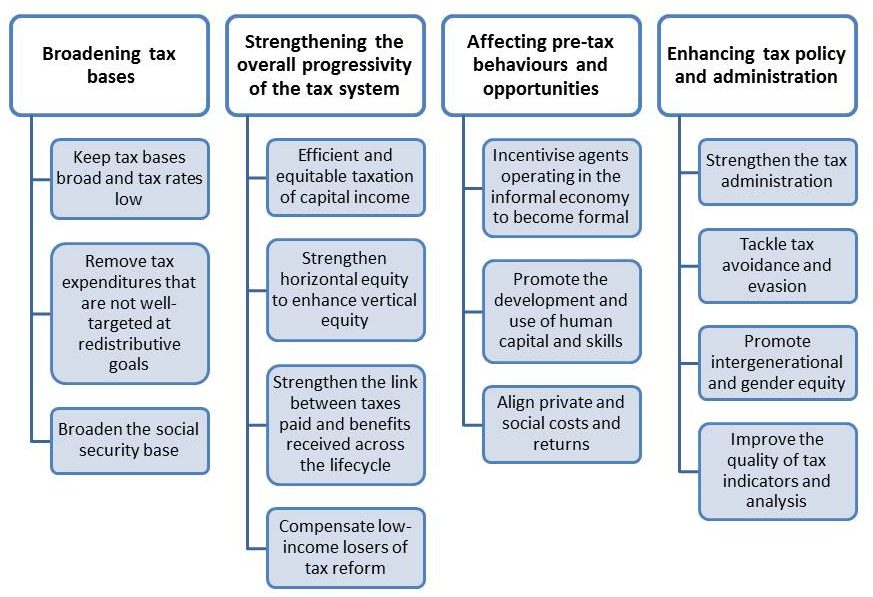Governments Should Use Tax Systems to Drive Inclusive Growth Agenda
David Bradbury and Bert Brys | 22 July 2016
Fiscal, Blog | Tags: Inequality, Tax Expenditures, Taxes
Tax policy design should play a key role in not only supporting growth but also in addressing distributional concerns.
Taxes affect inequality through different channels. The most direct way in which taxes redistribute income is by narrowing the distribution of (post-tax) disposable income. Taxes can also more indirectly reduce (pre-tax) market income inequality, for instance by encouraging labour market participation and stimulating individuals to invest in their human capital and skills or by limiting the perpetuation of income inequality across generations. Taxes also contribute to redistributing income across individuals’ lifecycles, for example by providing incentives for them to save for their retirement. More generally, taxes raise revenues which are used to finance public programmes, many of which are designed to reduce inequality.
Against this backdrop, and in view of historically high income and wealth inequality, a new OECD Working Paper Tax Design for Inclusive Economic Growth[1] examines the role of tax systems in promoting inclusive growth – economic growth where the benefits are more evenly shared between individuals across the income and wealth distribution. The topic will also be a key subject of discussion during a ministerial-level G20 Tax Symposium in Chengdu, China, just prior to the meeting of the G20 Finance Ministers and Central Bank Governors on 23-24 July.
By putting growth and equity considerations on an equal footing, the analysis in the paper goes beyond the traditional growth focus of the seminal 2008 OECD Tax and Economic Growth report, which established a ranking of taxes in terms of their negative impact on long-run GDP per capita.
It also emphasises the need to look at tax and benefit systems as a whole to fully assess the efficiency and equity implications of tax policies. Looking at taxes individually is critical, but it does not provide a full picture of the efficiency and equity implications of tax policies and may in fact exaggerate the trade-offs between the two objectives. The efficiency and equity effects of tax reforms will depend on a number of factors within tax systems, including how strongly taxpayers react to tax changes, the possibility for taxpayers to engage in tax-arbitrage behaviour (e.g. shifting highly taxed labour income into lower taxed capital income) or whether tax rules are properly enforced, as well as on factors beyond the tax system such as a country’s stage of development, social preferences for redistribution and the existence of compensation mechanisms. The interactions between taxes and other factors, both within and beyond the tax system, may reduce the trade-offs between efficiency and equity. In fact, in many cases, the big trade-off between efficiency and equity in tax policy may have been overstated. Many factors influence efficiency and equity trade-offs and a number of tax reforms can reconcile both objectives.
Based on this broader “systems approach”, the paper identifies a number of tax policy design options which can either contribute to jointly enhancing efficiency and equity or minimise the efficiency and equity trade-offs. These tax policy options can be grouped under four categories: broadening tax bases; strengthening the overall progressivity of the tax system; affecting pre-tax behaviours and opportunities; and enhancing tax policy and administration.

Countries can reconcile efficiency-equity trade-offs by broadening tax bases, in particular by removing tax expenditures that are not well-targeted at redistributive goals. Countries should also enhance the progressivity of their tax system beyond the personal income tax and take into account the overall progressivity of the tax and benefit system. A well-designed tax system should induce individuals to develop and optimally use their human capital and skills – the OECD will publish a Taxation and Skills report later this year which analyzes the financial incentives for both individuals and government to invest in skills. Countries should also aim at bringing informal taxpayers within the tax net through well designed tax policies and should consider the impact on gender and intergenerational equity of tax reform measures.
More analysis needs to be undertaken to identify the scenarios where tax reforms stimulate inclusive growth and those where they do not; and how such tax reforms will interact with a country’s existing tax policy settings, its level of inequality and its stage of development. More work is also needed on the distributional impacts and the incidence of taxes and tax expenditures, including recurrent taxes on immovable property and environmentally-related taxes, as well as on strategies that prevent tax shifting and behavioural responses to tax reforms. A “one-size fits all” inclusive growth tax reform does not exist. But options to use tax systems to foster inclusive growth should be firmly anchored on policymakers’ agendas.
[1] Brys, B., S. Perret, A. Thomas and P. O’Reilly (2016), “Tax Design for Inclusive Economic Growth,” OECD Taxation Working Paper, No. 26 (http://www.oecd-ilibrary.org/taxation/tax-design-for-inclusive-economic-growth_5jlv74ggk0g7-en).